Contents
Diseases and pests of peas are one of the main reasons for the death of a plant or a decrease in yields. In order for the fight to be effective, you need to be able to determine the cause of the disease and take the necessary measures.
Pea diseases and their control measures
Often gardeners pay attention to the plant when there are clear signs of the disease. In the early stages, the activity of bacteria and fungi manifests similar symptoms, so you need to be able to distinguish them from each other.
Mučnistaâ rosa
The disease is caused by fungi of the genus Erysiphe. Most often, cases of infection are recorded in the central and southern regions of pea cultivation.
Symptoms appear during the beginning of flowering and persist throughout the season. Leaves and stems with flowers become covered with a whitish coating during illness. As powdery mildew progresses, all parts of the pea are affected. Gradually, the plaque thickens, becomes a grayish tint. Leaves and flowers fall during the disease, the stem turns brown, the plant dies without treatment.
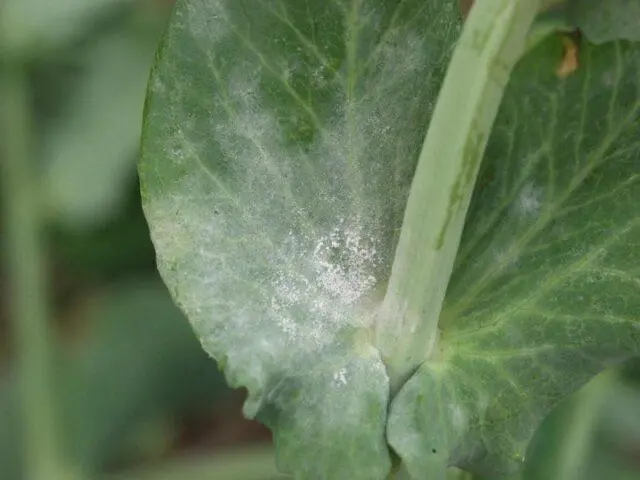
With powdery mildew, the use of fungicides Colosal Pro and Prozaro is effective
Ascochitosis
The cause of pea disease is the fungus Ascochyta. There are three varieties of it, which have similar symptoms when a culture is damaged.
The causative agent Ascochyta pisi is the cause of pale ascochyta. It affects more beans than stems. The disease is characterized by brown spots on peas, gradually turning pale in the center and changing color to gray-ocher towards the edge. The margin of the spots is dark brown. Infected seed dies or produces seedlings that do not survive.
Ascochyta pinodes is the cause of dark ascochyta blight on peas. The disease affects all parts of the culture. The spots are punctate, with a bulge, from 1 to 8 mm in diameter. They are darker in the center than at the edges.
On the stems are brown lesions of various sizes, dark brown or black. Seeds infected with ascochitosis do not germinate well, the root collar rots in pea sprouts.
Ascochyta pisicola causes a confluent form of the disease. Spots on affected plants are rounded, light-colored with a dark border. In the center of the foci are spores of the fungus.
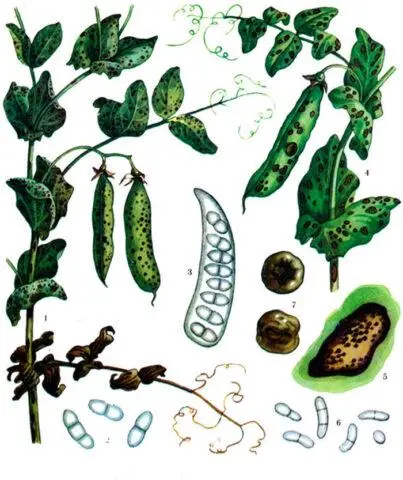
Effective for ascochitosis are drugs such as Akanto Plus, Prozaro, Sinclair, Maxim
Bacteriosis
The optimal conditions for the onset of the disease are humid and hot weather, a temperature of at least + 25-28 ° C. The causative agent is the bacterium Pseudomonas syringae.
Symptoms persist throughout the season: all parts of the culture are affected. There are spots that differ in shape and color. At first they are watery, then they become pale, greenish-brown in color with a dark center. The color of the entire leaf gradually changes during the disease.
As bacteriosis spreads, the plant dries up, turns yellow, and the ovary dies. Pea seeds do not ripen or are unsuitable for use.
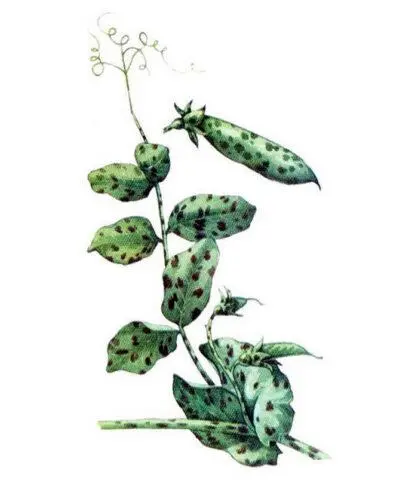
From bacteriosis, the bush must be treated with Gamair, Fitolavin or copper sulphate
Root rot (fusarium)
The disease is dangerous due to rotting and death of the roots. The cause is a fungus of the genus Fusarium.
Symptoms are expressed in the defeat of the root system and stems. If the disease progresses rapidly, then peas may die at the stage of germination. During external examination, light brown blurred stripes and spots can be seen on the aerial part of the culture. Gradually they darken and merge together. The plant dries up and dies from the disease.
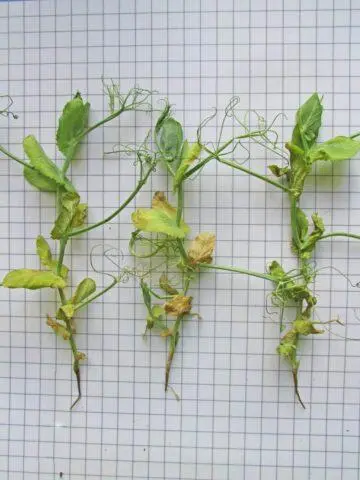
In the early stages, Fusarium can be treated with Colosal Pro.
Downy Mildew
Most often, the disease is recorded in the Kaliningrad region, in the northern region and in the Caucasus. The reason is spores that have successfully overwintered in the soil.
Downy mildew affects the entire aerial part of peas. The disease can be local and diffuse forms. The first is characterized by damage to the leaves: whitish or yellowish spots appear on their outer side, and a gray cobweb coating appears on the lower part during the rainy season. On stems and beans, foci of the disease can also be found. Peas gradually lag behind in growth, the culture becomes outwardly similar to a cauliflower head.

With downy mildew, effective remedies such as Fitosporin, Alirin
Mosaic
The pea disease is caused by Pisum virus 2 Smith. It can remain active for 45-50 days, is not transmitted by seeds.
Mosaic appears as mottled and wrinkled leaves. At first, chlorotic spots appear on them, which turn white over time. Affected pea seeds during the disease period can be identified by an intense yellow color.
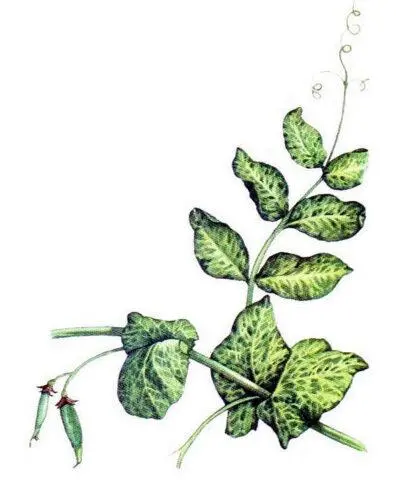
There are no drugs for the treatment of mosaic, the plant should be destroyed
To prevent the spread of the disease, you need to treat the peas with a solution of karbofos: 75 g of the substance per 10 liters of water.
Rust
The disease is the result of the activity of the fungus Uromyces pis. It affects the stems and leaves of peas. Most often, cases of the disease are recorded in the northern regions of Europe.
Rust symptoms can be detected during the flowering period. Light brown pustules appear on the aerial part of the plant. Over time, the pea bush dries out prematurely from the disease, the beans do not have time to ripen.

To get rid of rust, it is recommended to irrigate the plant with products such as Akanto Plus or Colosal Pro
Gray mold
It is caused by the fungus Botrytis cinerea Per. Its spores are perfectly preserved in the soil and seeds, and are activated in a favorable environment.
Gray rot can destroy the entire crop. To identify it, it is enough to examine the plant. Flowers during the disease change color to brown, mushroom spores remain on their petals. Pea buds wilt and fall off, allowing the infection to spread throughout the plant. Dirty green spots can be seen on the underside of the leaves. Gradually, the shoots of peas begin to rot, become covered with a gray coating.
Treatment of the disease consists in the use of fungicides Scarlet, Fitosporin-M.

A favorable environment for gray rot is high humidity and heat.
Pea pests and their control
Insects and beetles can cause tremendous damage to the crop, so the gardener must be able to deal with them. Disinsection methods depend on the definition of the type of pest.
Pea kernel
The adult beetle is broadly oval in shape, black in color, with grayish hairs and a white spot on the abdomen. The pest hibernates inside the pea, in the spring it feeds on the flowers of the crop.
The females lay their eggs in the leaves of legumes. The larvae feed on the contents of the fruit, where they turn into pupae.
To identify the pest, you need to inspect the seed. There will be dark spots on the shells of the peas, and a hole will also be visible on the surface.
To separate healthy legumes from damaged ones, it is enough to immerse them in a solution of table salt. To do this, add 1 kg of the substance to 3-3,5 liters of water. Peas unsuitable for sowing will float.
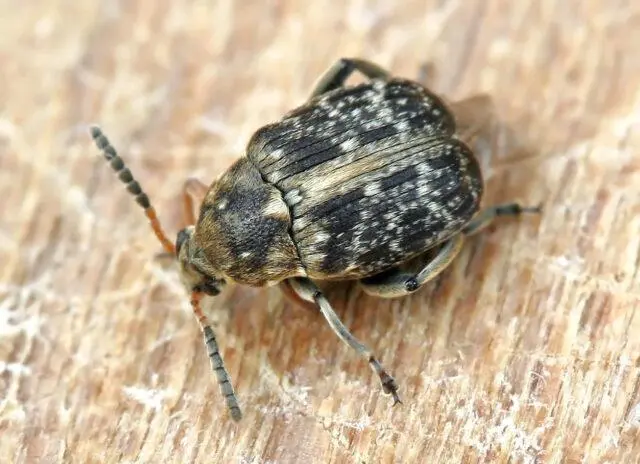
The length of the pest pea weevil is 4-6 mm
Pea fruit moth
The butterfly reaches 12-17 mm in wingspan. The anterior ones are dark brown, with white stripes along the edge. The head and thoracic shield are grey. The caterpillar of the pea pest is pale yellow in color, up to 12 mm in length.
The codling moth develops in one generation, hibernates in the soil, wrapping itself in a cocoon. In the spring, it pupates, and the cycle of development is repeated. Peas serve as food for the pest. When the larva takes the maximum amount of nutrients, it leaves the legumes and hides in the ground.
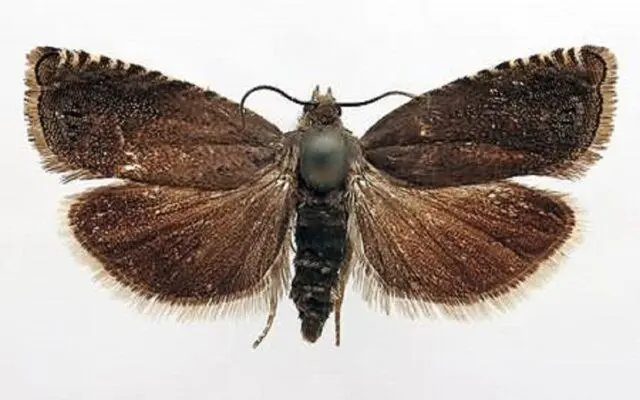
The only way to deal with the codling moth is the early sowing of early ripening pea varieties, as well as deep digging of the soil.
Horohovaya aphid
The pest lives on wild legumes. Differs in large sizes, up to 5,5 mm in length. Its color is dark green, with long juice tubes. Aphids can produce up to ten generations per year.
The pest sucks the juice from the leaves and shoots. Because of this, the peas begin to lag behind in growth, turn yellow, lose their ovaries and gradually die.
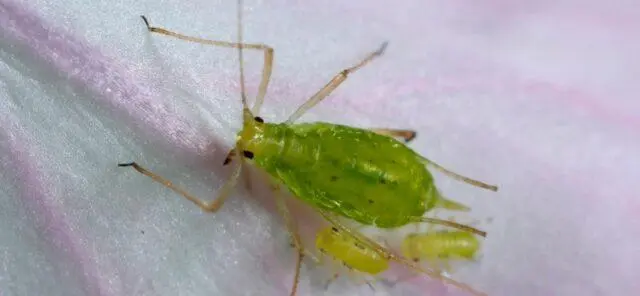
If no measures are taken, then by the end of the season the aphid creates a whole colony that can completely destroy the crop.
Pest control methods involve early sowing of peas. It is recommended to carry out timely destruction of weeds. Bushes should be sprayed with Fury’s solution. It is important to carry out the procedure no later than ten days before harvest.
bean moth
The pest reaches a wingspan of 26 mm. Its front wings are brown, with a gray tint, a white stripe and an orange spot. Butterflies actively appear in May and stop their activity only in September. But moth caterpillars cause great harm to peas. They eat the beans whole.
To destroy the moth, it is recommended to plant early ripe varieties of peas in the spring. After harvesting the legumes, dig deep into the soil.
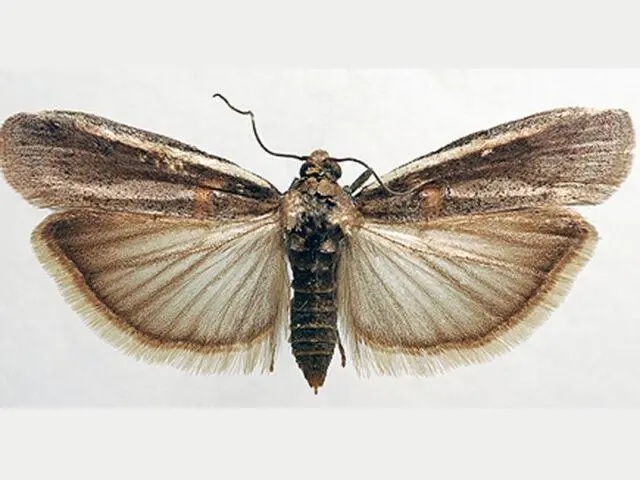
For wintering, the bean moth hides in the ground
Umbrella blotch
Small insect of pale green color. The pest damages the leaf plates by sucking the juice out of them. Because of this, the plant lags behind in growth, the yield of peas decreases.
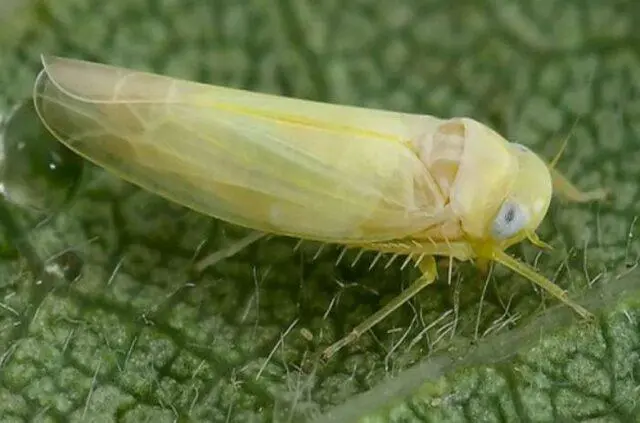
The larvae of the psyllid are greenish-yellow
As pesticides, you can use drugs Decis, Kinmiks, Karbofos.
Colorado beetle
Despite all the assurances, the insect is able to eat not only potatoes, but also peas. This can be determined by detecting a beetle on the leaves of the culture. The pest safely destroys the aerial part of the plant, if no action is taken.
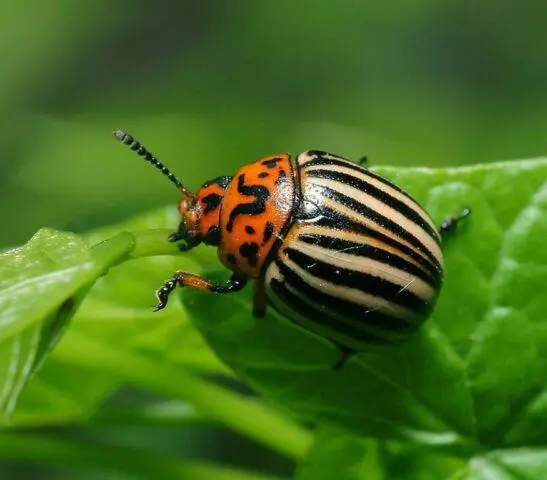
Actellik, Confidor are effective means for combating the beetle.
nodule weevil
There are two types of pest: striped and bristly. Beetles have an elongated body up to 5 mm long. The striped weevil has elytra with stripes. The bristly appearance has cilia along the upper edge of the eye, there is no striation.
The pest develops in one generation per year. Beetles overwinter in the soil, preferring beds with legumes. In the spring they appear with the onset of spring. By the end of June, the number of pea pests begins to decrease. On sunny days, beetles actively climb plants and eat it.
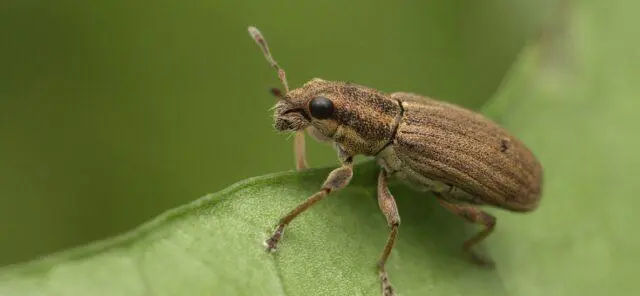
An effective drug for nodule weevil is Karbofos
Helps to reduce the activity of the pest early sowing of peas, digging beds in late autumn.
chickpea miner fly
The pest reaches a length of up to 2 mm, it is black in color, with yellow antennae. The fly eats only chickpeas.
Pupae overwinter in the soil. In May, they come to the surface of the earth, lay their eggs in the leaves. The larvae suck out the juice, and then go into the soil, where they pupate. During the year, the pest is able to form 3-4 generations. The plant dries out as the fly is detailed and gradually dies.
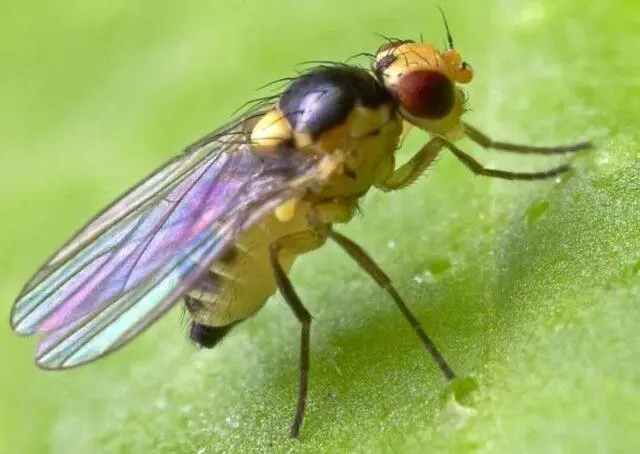
Treatment of peas with Fury is recommended as a control measure.
For prevention, you can regularly loosen the aisles. After harvesting, you need to dig up the ground.
Protection of peas from pests and diseases
To preserve the crop, it is easier to take preventive measures than to get rid of the consequences, so you should follow the recommendations:
- you can not plant peas on the same bed for several years in a row;
- you need to regularly treat the site with legume fungicides, Bordeaux mixture;
- take into account the varietal characteristics of the plant, the nuances of its cultivation in certain types of plots;
- timely and carefully select seed;
- dig the soil deep in the fall.
Conclusion
Diseases and pests of peas can cause significant damage not only to one crop, but also to the site as a whole. When growing legumes, it is necessary to carry out prevention in a timely manner, and when signs of the disease appear, promptly take appropriate measures.









